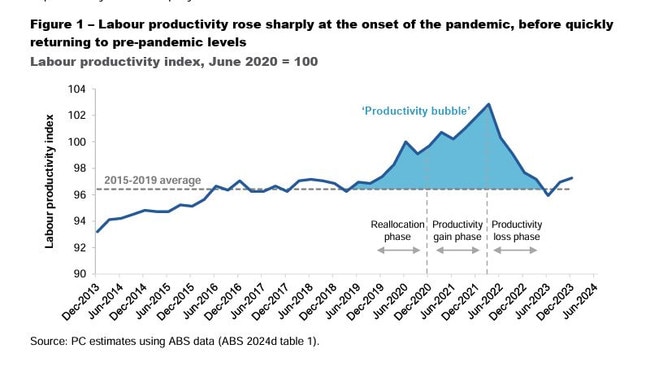New report settles Australia’s working from home debate once and for all
A huge call has been made on working from home in Australia, settling the divisive debate once and for all.
Business
Don't miss out on the headlines from Business. Followed categories will be added to My News.
This year we have seen a notable uptick in companies rolling back flexible working arrangements, with staff forced back into the office five days a week.
One of the most common reasons bosses often give for scrapping remote and hybrid work is to “improve productivity”.
Well, we now have confirmation this is (most likely) not the truth.
A new report from The Productivity Commission has explored the reason behind the Australian workforce’s dip in productivity and, surprise surprise, working from home is not to blame.
The report explores the phenomenon known as the “Covid productivity bubble”, which is where labour productivity rose to a record high between January 2020 and March 2022, before returning to pre-pandemic levels in June 2023.
The Productivity Commission found the “bubble” only served to mask the issues of Australia’s ongoing productivity problem.
“The Covid-19 pandemic was a rollercoaster for productivity, but we are now back to the stagnant status quo,” Deputy Chair Dr Alex Robson said.

MORE: The best work-from-home jobs in Australia
The “productivity loss” phase between June 2022 and June 2023 has been attributed to a surge in the labour market as Covid restrictions eased.
Since then, the hours Australians work each week have been soaring, but this has not been matched by investment in systems and equipment needed to get the most out of the workforce, hence the drop in productivity, according to the report.
One of the lasting changes brought on by the Covid-19 pandemic and subsequent lockdowns has been the shift to hybrid models.
While there has been a push to get people back into the office full time, the rates of working from home are still significantly higher than pre-pandemic levels.
According to the report, prior to the pandemic, 11 per cent of working age Australian adults reported working from home at least once a week over the previous four weeks, and 12 per cent worked from home on all or most days a week.
During the severe lockdown, the proportion of those working from home at least once a week decreased to nine per cent and the number of people working remotely all or most days increased to 31 per cent.

MORE: How to negotiate working from home
In April 2022, after lockdowns and restrictions eased, rates went to 18 per cent at least once a week and 27 per cent all or most days, indicating an increased popularity in hybrid arrangements.
By August 2024, an Australian Bureau of Statistics survey showed 36 per cent of people reported that they usually work from home, indicating a sustained shift in work practices.
Despite concerns and even some claims from industry leaders that the working from home shift would lead to productivity loss, the Productivity Commission found it didn’t have any negative implications and, in fact, hybrid work can be beneficial.
“Workers do not need to be in the office full-time to experience the benefits of in-person interactions. As a result, hybrid work tends to be beneficial to productivity, or at least, is not detrimental to productivity,” the report states.
Sabrina Scherm, customer success manager at HR technology company HiBob, claimed many companies are actually making the productivity problem worse with return to office mandates.
“These mandates fundamentally ignore the lessons learned during the pandemic’s so-called ‘productivity bubble’, where workers demonstrated they could be highly effective when given the flexibility and autonomy to manage their time and working environment,” she said.
“To force employees back into rigid structures isn’t just misguided; it actively risks stifling future productivity gains.
“Instead of focusing on an attendance-first mindset, the conversation must be around a results-first mindset. And we need to stop associating ‘harder’ work with ‘longer’ work.”
Allowing workers to work from home some days a week can improve employee satisfaction and allows people the benefit of avoiding a commute, meaning they have additional time for other purposes, the report stated.
The research also cited studies that indicate remote work can reduce breaks and sick days and result in less distractions, all of which are typically found to be beneficial to productivity.
Ms Scherm believes the path to sustainable productivity lies in working “smarter”.
“That means embracing modern tech to automate mundane, time-consuming tasks that add hours but little value,” she said.
“We can achieve genuine, long-term productivity gains by freeing up our workforce to focus on innovation and high-impact activities.”
However, the report also included claims that fully remote work could have a greater negative impact on less experienced workers.
For those starting out in the workforce, in-person interaction may be important for skill development “as there may be a greater knowledge transfer from senior workers and junior workers through informal in-person interactions”.
The Commission noted that the evidence on working from home is still evolving but, ultimately found hybrid work has either had a neutral or positive for labour productivity.
“There is no evidence to suggests that the trend towards hybrid working has contributed to the productivity loss phase of the productivity bubble,” the report stated.
Originally published as New report settles Australia’s working from home debate once and for all



